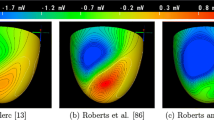Abstract
The macroscopic resistivity of canine ventricular tissue has been measuredin vivo. Using a tetrapolar intramural electrode, values have been obtained for transmural resistivity as a function of depth, phase of the cardiac cycle and of the frequency of the applied current. The time course of resistivity owing to induced local ischaemia has been recorded. Using epicardial electrodes, the amount of anisotropy of the macroscopic resistivity has been estimated. The results obtained put the transmural resistivity at about 410 Ωcm and show it to be independent of the cardiac phase, independent of frequency and independent of depth. Induced local ischaemia was found to be followed by a substantial increase in the resistivity with time. The amount of anisotropy observed epicardially shows the ratio of transverse to longitudinal resistivity to be of the order of 2. These results are discussed in relation to a cylindrical model of the underlying fibre structure.
Similar content being viewed by others
References
Boer, R. W. de andOosterom, A. van (1978) Electrical properties of platinum electrodes.Med. & Biol. Eng.,16, 1–10.
Burger, H. C. andDongen, R. van (1961) Specific electric resistance of body tissues.Physics in Med. & Biol.,5, 431–447.
Cole, K. S. andCurtis, H. J. (1950) Electric physiology.In Glasser, O. (Ed.)Medical physics, The Year Book Publ. Inc., Chicago, 82–90.
Durrer, D., Lier, A. A. van andBüller, J. (1964) Epicardial and intramural excitation in chronic myocardial infarctionAm. Heart J.,68, 765–776.
Handbook of Chemistry and Physics, 44th edn (1961) The Chemical Rubber Publishing Company, Cleveland, 2691–2695.
Kohlrausch, F. andHolborn, L. (1898)Leitverm. der Electrolyten, Teubner, Leipzig.
Panofski, W. K. H. andPhillips, M. (1962)Classical electricity and magnetism, Addison-Wesley, London.
Rush, S., Abildskov, J. A. andMcFee, R. (1963) Resistivity of body tissues at low frequencies.Circulation Res.,12, 40–50.
Rush, S. andNelson, C. V. (1976) The effects of electrical inhomogeneity and anisotropy of thoracic tissues on the field of the heart.In Nelson, C. V. andGeselowitz, D. B. (Eds.)The theoretical basis of electrocardiology, Clarendon Press, Oxford, 323–354.
Schwan, H. P. andKay, C. F. (1956) Specific resistance of body tissues.Circulation Res.,4, 664–670.
Thalen, H. J. T. (1969) The artificial pacemaker. Thesis, University of Groningen.
Weidmann, S. (1970) Electrical constants of trabecular muscle from mammalian heart.J. Physiol.,210, 1041–1054.
Author information
Authors and Affiliations
Rights and permissions
About this article
Cite this article
van Oosterom, A., de Boer, R.W. & van Dam, R.T. Intramural resistivity of cardiac tissue. Med. Biol. Eng. Comput. 17, 337–343 (1979). https://doi.org/10.1007/BF02443820
Received:
Issue Date:
DOI: https://doi.org/10.1007/BF02443820




